2000 Anaylsis of the Philadelphia Stadium
Situation
By Sandor Gulyas
I originally wrote this paper in 2000, hense the
title. In the time since I wrote this, I have have found more
support material concerning the history of the football and baseball
teams of Philadelphia in reference to their playing locations
within Philadelphia. That means somewhere down the line I will
be updating/rewriting this paper to reflect the knowledge I've
gain since I first wrote this. Stay Tuned....
There are a myriad decisions to be made before any city infrastructure
is built. From the county, city, or state lining up the political
support, arraigning
land assembly, tax rebates, and finances to the team deciding
on where (both macro and micro scale), scale of stadium, and their
investment into the process.
One of the current locations in the national stadium debate is
Philadelphia, Pennsylvania. For six years now the city and, primarily,
their local baseball team, the Philadelphia Phillies, have been
debating about securing a new stadium location. There are two
options being considered by city council and the team. One would
put the Phillies "baseball only" stadium in Center City
Philadelphia. The other would put a stadium in South Philadelphia.
Almost as an afterthought, the local football team, would build
a new "football only" facility near the current dual
sport stadium just south of center city.
What this paper is about is the interactions between new sports
stadiums and their cities. What I will discuss is why stadiums
get built, how they are financed, those cities responses to the
challenges of getting them constructed, and the history and political
bickering that has enthralled Philadelphia in their most recent
stadium case. What does a new stadium do for a community?
History
Cities financing new stadiums isn't as recent a trend as one
would think. The first case of a city using municipal funds to
build a new stadium was Cleveland, Ohio in 1928. Cleveland Municipal
Stadium was finished in 1932, built in the beginning of the great
depression, it was part of the city's plan to attract the 1932
Summer Olympics (Gershman 142). It wasn't built with Cleveland's
baseball team in mind; they continued to play in League Park till
1946 (though they would play nights and weekends at Municipal
Stadium), and professional football wouldn't arrive till the late
thirties (in the form of the now St. Louis Rams) to Cleveland
as well. The first stadium built via public funds specifically
for a particular professional sport would be Milwaukee County
Stadium. Financing was approved and construction started in 1950
and was finished in 1953 in time for the Boston Braves baseball
team to become the Milwaukee Braves baseball team (Gershman 165).
At that time new stadiums, or updating or remodeling minor league
parks, were done more for getting a major league team for the
town's image, not as much for urban renewal. Though that would
change in the sixties.
Starting in the 1960s new stadiums served a double purpose. One,
to keep the teams "home" and not become someone else's
gold mine (Gershman 191);
and two as part of that community's urban renewal and economic
plan (Chema 20). In the case of the latter, the stadiums weren't
thought of as generating urban renewal, but as being part of the
greater scheme of urban renewal.
The idea was to take out two dilapidated areas (where the team
once played, and the area where the team would play) and replace
them with two new tax generating areas. In Cincinnati, the land
that was Crosley Field became an Industrial Park. In Pittsburgh,
Forbes Field was torn down and the land was incorporated into
the University of Pittsburgh (see map below), while both cities
built new stadiums on their riverfront (Gershman 198).

The two Pittsburgh baseball park locations
Though that's not always the case. After the 1970 season, The
Philadelphia Phillies started play in their new stadium, Veterans
Stadium, on the south side of town. The following year, Connie
Mack Stadium, the former home for the town's baseball team, on
the north side of Philadelphia, was damaged by fire. It stood,
as an eyesore for another five years till it was demolished in
1976 (Gershman 210). That plot of land stood unused for another
15 years till a church was built on its site in 1991 (Lowry 211).
Veterans Stadium was incorporated into an area on South Broad
Street called the Sports Complex, so named for (then) having The
Spectrum for indoor sports, The Vet (as it's so called by the
locals) for outdoor sports, and JFK Stadium for other activities.
The only attraction for all being there? Easy access by car being
between two freeways due to its location.
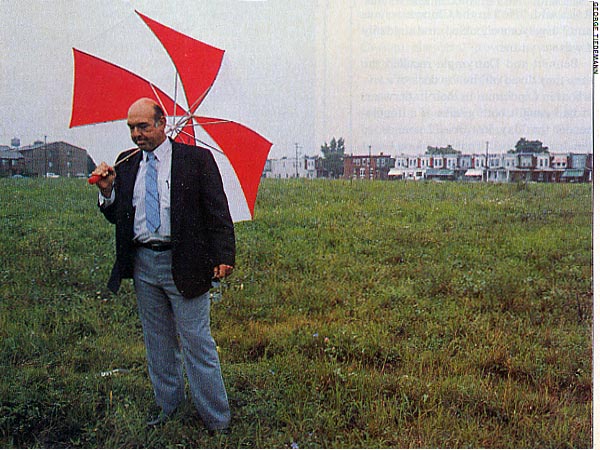
Former Phils player Clay Dalrymple
walks the lot that was Connie Mack Stadium in 1989 (Photo by George
Tiedemann, Sports Illustrated)
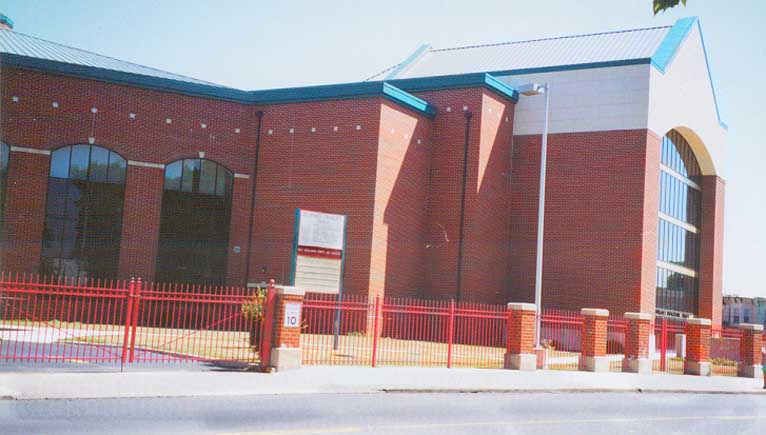
The Deliverance Evengelical Church
stands where Connie Mack Stadium once stood (Photo taken by author
in 2001)
The Commodity
In the most recent round of stadium building, the idea of the
stadium as an investment has taken hold (Baade 2): the idea that
improved stadiums will create jobs, create a place to go to, and
start the urban renewal of an area. The proof however is quite
the opposite. What is the benefit to a local community if the
stadium contains all the amenities that a community would use
for it's economic well being? The owners of the sports franchise
get the receipts for the parking. They have food by way of their
vendors inside the stadium and having a bar and/or restaurant
built into the stadium as well. All the money in there goes to
the owner(s) of the 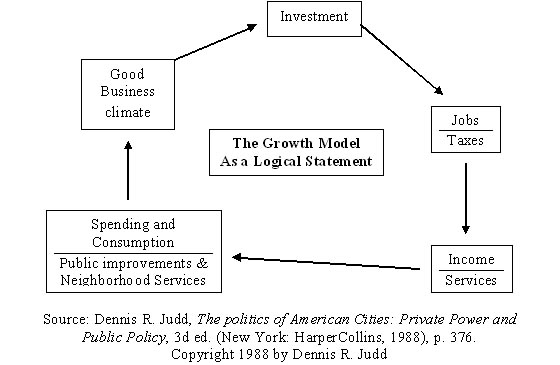 franchise (Cagan & deMause 147).
franchise (Cagan & deMause 147).
The community on the other hand gets nothing back in return Thev
get no money from public parking, for there are no public lots,
or already agreed to hand over the parking money to the team.
They can't even get money from parking tickets because there will
be an over abundance of parking lots so the customer won't have
the inconvenience of making sure they are parked legally. The
community's restaurants and bars get little or no traffic since
the fans will drive to one place, that being the stadium, instead
of making multiple stops. They will reside at the stadium's bar
or restaurant, being that it is conveniently located where they
are going to see the game (Cagan & deMause 141 ). The local
police department can't even get anything out of this arrangement.
If you crowd 20,000 cars into several parking lots, near to each
other, there will be no speeding. With all the lots, there will
be no illegal parking. All you have is traffic control as an expenditure
and nothing coming in as income. How can you have a win-win proposal
if the owners of the ball teams want every conceivable convenience
for their fans under their control?
When it comes to putting the new stadium in, there comes the sticky
situation of land assembly. The bigger the stadium, the more land
that is needed. If more land is needed, does one go to the suburbs
or beyond where fewer parcels are needed to be purchased and could
be less expensive to purchase? Do they instead stay in the city
and take their chances getting everything together sooner than
later. In actuality, only eight cities, currently and formerly,
had any of their sports teams playing in their suburbs (see chart
below). In seven of the cities, the football team played out in
the suburbs, in four of the cities the basketball team played
away from the city, in another three cities the baseball team
played away from the city. In one of the cases, the sport team
started out in the suburbs, then moved to the city, while the
former stadium was razed and the land eventually used as part
of a new mall (Lowry 181 ). This begs the question, why do most
of the teams (eighty four of ninety four professional teams) stay
within their home city's limits?
Chart of suburbs that host(ed) professional
sports teams
|
City |
Football |
Baseball |
Basketball |
|
Boston |
Foxburo |
|
|
|
Cleveland* |
|
|
Richfield |
|
Dallas |
Irving |
Arlington |
|
|
Detroit* |
Pontiac |
|
Auburn Hills |
|
Los Angeles* |
Anaheim |
Anaheim |
|
|
Minneapolis* |
Bloomington |
Bloomington |
|
|
New York City |
East Rutherford |
|
East Rutherford |
|
Washington D.C. |
Palmer Park |
|
Largo |
*- indicates that city doesn't have team(s) playing in
those suburbs anymore
The two possible conclusions for this would be the lack of
services the suburbs could provide (primarily water & sewer
and transportation) and residents of the suburb(s) not willing
to put up with the inconveniences of traffic, noise, and litter
caused by the inclusion of a new facility near them (Cox 29).
Any suburb lacking a freeway and an interchange from that freeway
would be at a disadvantage at attracting a sports stadium. The
city that controls the area's water and sewage will also dictate
where any new infrastructure would be built in the area as well.
With those factors against movement from the inner-city, the team
and its owners will look for the easiest way to do land assembly,
and over the course of recent sports history, governments have
helped the teams via eminent domain.
The inner city stadium: two scenarios
In urban renewal, the city will claim land by defining the needed
area, for the building, as being blighted and needing redevelopment.
Then eminent domain is
used by the government to obtain the land at a reduced rate than
what the market will give (Davis & Whinston 187). Then the
city can proceed with construction of the new structure and can
sell any extra land to developers to construct housing, or commercial
uses.
If only the stadium and nothing else is developed in the degenerated
section, then the investment by the city is lost. Customers will
go to the stadium and leave afterwards. There is nothing to keep
them around the neighborhood. Furthermore, if the stadium is the
only new structure built in the depressed area, then people going
to the stadium will think of their safety and travel by car so
as to avoid being in and around the area, before and after the
activity they attended. With that kind of structure, any other
sort of transportation (bus, subway, train, etc.) will never see
any attendance figured for it, because no one will want to risk
waiting or staying in a neighborhood one believes to be dangerous
(Gershman 234).On the other hand, you go through the first three
steps, mentioned before, but you have more land that can be redeveloped
than is needed by the city for the stadium. Then a neighborhood
can be created either by the government or developers. If the
creation of commercial, mixed use, or residential land is done,
then the investment by the city in the stadium can be paid off
via the other services the neighborhood provides citizens before
and after the activity they attend (Chema 20). Clean and walkable
streets, familiar emblems, and a comfortable environment will
encourage the "revitalization" of the area. Once the
neighborhood is established (or if by luck a new stadium intermeshes
with an existing neighborhood), the inclusion of mass transit
in there can further develop this sense of people feeling comfortable
being in the area. Therefore, they will leave their vehicles further
away or possibly not use them at all. though the buses, trains,
subways, or even trolleys must still run on time (having someone
stand in the rain because their connecting ride is fifteen minutes
late can hinder progress).
In the case of Philadelphia, before Veterans Stadium was completed,
the baseball and football teams played in different facilities.
Accessibility to either one was not easy. The baseball team played
at Connie Mack Stadium. It was in the middle of a working class
neighborhood. Access to the stadium by car was poor and parking
was lacking. The nearest train/subway station was five blocks
to the east of the stadium.
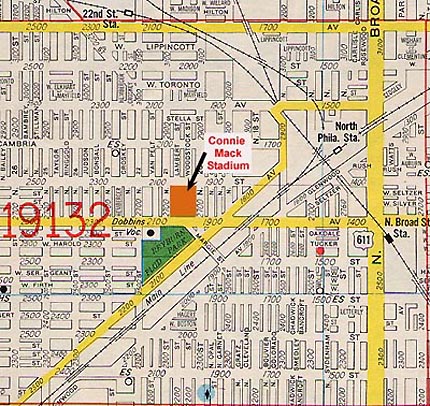
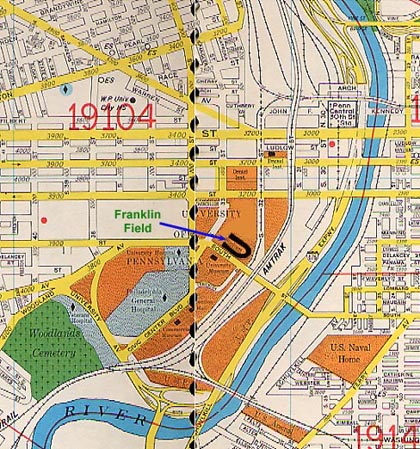 On the left, Connie Mack Stadium and the surounding
area. On the right, Franklin Field and the surounding area.
(Hagstrom map, 1980 copyright)
On the left, Connie Mack Stadium and the surounding
area. On the right, Franklin Field and the surounding area.
(Hagstrom map, 1980 copyright)
The football team played at Franklin Field on the grounds of
the University of Pennsylvania. Parking and access was average
(there is an exit with an interstate half a mile east of the stadium),
but not tremendous. The nearest train station was six blocks to
the northeast. but it was the Penn Central station for Philadelphia
so one could go anywhere on the east coast with ease from there.
With Veterans Stadium, you had an east-west freeway just to the
north of the stadium. You had a north-south freeway a mile and
a half south of the stadium (though the southern portion wouldn't
be completed till 1986). There was plenty of parking, due to the
combining of all the sports facilities in one area. The city also
extended the Broad Street subway line so there was a station next
to the stadium for those who couldn't or wouldn't use their cars.
It was not easy, all decisions made were political.
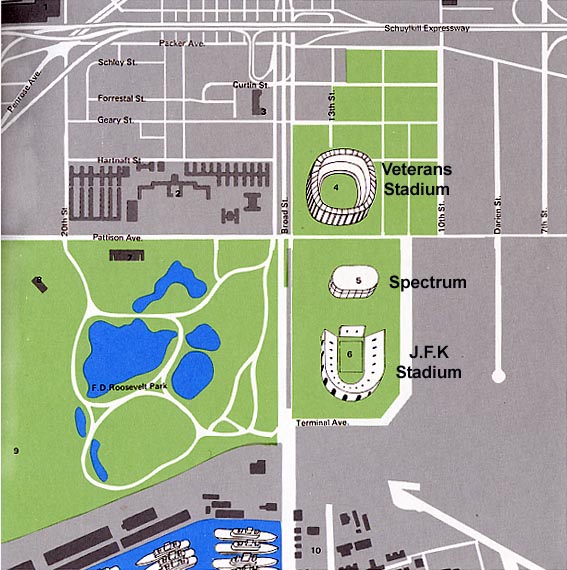
The original Philadelphia Sports
Complex, circa 1972
Bridging the Divide
Politicians like safe issues. Everyone is happy with the decision
and reelection is easy. Sports is an easy issue. Support the home
team. As a politician, however, support has other conotated meanings
to both the owners and the fans of the team.
For the owner, competition has its price in the way of salary
for the performers (meaning the players). To subsidize that price,
other income streams must be
found, and/or other costs must be reduced (Greenberg & Grey
136-138). Many of those solutions go through city hall or even
the statehouse. The owners will
plead poverty (as compared to the rest of the league) to the fans
in an attempt to get their help (Rosentraub, 1999).
To the fan, what is best for the team always comes out ahead.
The team needs good players to win championships. To get those
good players, however
the owners need money to pay the premium price for the best players
(Fizel, Gustafson, Hadley 83). The team can come out and say how
local officials are being unreasonable and they need more money
from the rent, the concessions, parking, or naming rights. The
fans will want the best for their team and interrogate the officials
who won't hand over the money for the team to do well. The good
of the city? Does it come by way of sport championships or quality
of life? The electorate can be fairly divided about that issue.
The points the electorate can split on are tax abatements and
subsidies. If the city builds the stadium, then they rent out
the space for those who want to use the space and the money from
that will repay the debt from construction (Greenberg & Grey
338). The sport team will want the rent as little as possible
so they have more money for other uses (Rosentraub 1999). If the
owner of the stadium (usually some bureaucratic body) reduces
the rent, then they will need to find other means to pay for the
stadium. It is there that a division point is created. If you
raise personal taxes, then the affected populace will not be happy.
Take money away from other services to cover the stadium, then
those who need those services will not be happy. If you have a
motel or taxi surcharge, then you'll see customers go elsewhere
or use other means in the metro area. You can have businesses
pay the difference, but your economy could be affected. Businesses
could move out or layoff workers. Mot a good situation for the
city in either case. There are many decisions that go into how
to finance a stadium. In the case of Philadelphia,
they are still going through many decisions that concern the current
and future stadiums there.
Philadelphia Time
As mentioned on the first page of this paper, conversations
about replacing Veterans Stadium have been going on since 1994.
In the last three years, those conversations have become definite
plans. Coming to the new stadium game in the middle of this current
cycle of stadium building has provided Philadelphia the ability
to avoid some of the mistakes others before them had made. Already
news services reported back in February of 1999 that the state,
the city, and each sport team would divide the cost for the stadiums
between them equally, with each paying one third of the total.
The state and the sport teams have already put in their share,
it's the city of Philadelphia that is dragging its feet on the
money. There are two basic problems that are holding back Philadelphia's
part in this deal. The problems are where to build the baseball
stadium and how will the city finance their part of it. The original
idea was for the baseball only stadium to be on the north side
of downtown Philadelphia near the intersection of Broad and Spring
Garden Streets. It would been a fairly easy deal to pull off.
Only three properties to claim, one property belonged to the state,
anotherbelonged to the local newspaper publisher. It looked to
be fairly easy. However, one of the city council members was against
the plan because it affected his constituents negatively. Not
only the people living in the area, but those who worked at the
state office building didn't want to move or lose their jobs.
Then, some properties were sold in the area. That raised land
costs along which in turn raised the cost of the total project.
With the possibility of protest delaying indefinitely construction
and escalating land prices at their original site, then Mayor
Ed Rendell and the owners of the Phillies decided that the new
baseball stadium would instead be built near where the rest of
the stadiums and arenas are located, in South Philadelphia. The
plan would have the baseball stadium built to the northeast of
the current stadium (the Vet) on the stadium's north lot (Burton
& Yant 2-3). Still there were complaints and protests over
this site as well. Residents, who live to the west and north of
the South Philadelphia Sports Complex, brought out complaints
about what they have to endure currently with noise, litter, and
parking from the current facilities (Davies 8). They also had
a major ally on city council. Their city council representative
is the president over City Council. They might also have another
ally in the mayor. Back in April,2000, Mayor John Street came
forward with a proposal to build the new baseball only stadium
near the intersection of 12th and Vine Streets. It would be only
three blocks east of the original proposal for a baseball stadium.
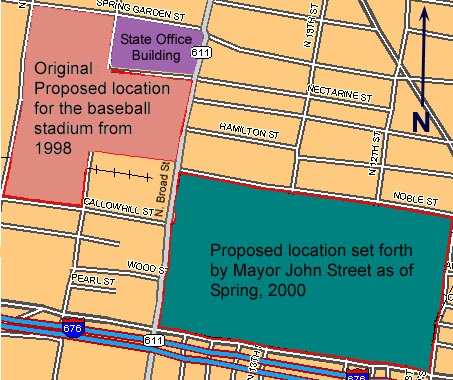 John Street's proposal has several flaws to it. The first flaw
is in his proposal, is that there would be a hundred or more properties
to acquire in this plan as compared to the three properties at
Broad and Spring Garden or one at the stadium complex (Conlon
28). The second flaw is the time schedule. If the 12th and Vine
proposal is chosen, the new stadium won't be completed till 2005
at the earliest (Conlon 28). If the South Philadelphia were to
go through, it could be finished in 2003 (Benson 1 ) The last
flaw is the potential cost of building at 12th and Vine. Figures
for there are ranging from seven hundred million to one billion
dollars when all is said and done for that location. Estimates
for a new stadium in South Philadelphia have it around three hundred
fifty million dollars (Bostrom 4). With the state of Pennsylvania
already having eighty two million dollars (out of three hundred
fifty million for new stadiums in Philadelphia and Pittsburgh)
set aside for the building of a new baseball stadium in Philadelphia,
neither the team nor the state are interested in increasing their
cost in building a new stadium.
John Street's proposal has several flaws to it. The first flaw
is in his proposal, is that there would be a hundred or more properties
to acquire in this plan as compared to the three properties at
Broad and Spring Garden or one at the stadium complex (Conlon
28). The second flaw is the time schedule. If the 12th and Vine
proposal is chosen, the new stadium won't be completed till 2005
at the earliest (Conlon 28). If the South Philadelphia were to
go through, it could be finished in 2003 (Benson 1 ) The last
flaw is the potential cost of building at 12th and Vine. Figures
for there are ranging from seven hundred million to one billion
dollars when all is said and done for that location. Estimates
for a new stadium in South Philadelphia have it around three hundred
fifty million dollars (Bostrom 4). With the state of Pennsylvania
already having eighty two million dollars (out of three hundred
fifty million for new stadiums in Philadelphia and Pittsburgh)
set aside for the building of a new baseball stadium in Philadelphia,
neither the team nor the state are interested in increasing their
cost in building a new stadium.
Meanwhile, the Philadelphia Eagles football team has stayed in
the background during these proceedings. While everyone debates
where the baseball stadium should be, everyone involved has agreed
that the new football stadium should be built in South Philadelphia
(Hearsh 4). Designs for the stadium and its placement have already
been decided. The reason it hasn't been built is that the owners
of the football team have been unwilling to separate their part
in the city stadium funding deal from the baseball team. Why won't
the owners of the football team stand up and get a separate deal?
No one is certain, but the owners aren't familiar with Philadelphia
politics (they have only owned the team for four years and are
from Boston and Los Angeles respectively), and the team's recent
performance on the field has not inspired the city to help them.
As of the original writing, nothing had been settled concerning
when and where any stadiums will be built in Philadelphia.
Conclusion
Will it be worth Philadelphia's well being to build two new
stadiums for both of their sports teams? Seven hundred million
dollars for one stadium will outweigh any good that stadium can
produce directly or indirectly to a neighborhood. It would be
too much debt for any party involved to carry. However, it is
wise to spread the cost of building over as many different parties
as possible. It lowers the risk and doesn't hinder the governments
in funding other projects. Costs of stadiums will not go down.
As long as teams want stadiums more spread out and not towering
over the field, more land will be needed. As long as teams, and
governments, want stadiums constructed in urban areas, land prices
will be expensive. The combination of excesses in quantity of
land and cost of land will make government only investments in
subsidized infrastructures too exorberent to build.
The new round of stadiums effects on cities have yet to be fully
understood. Those who are against their subsidizing use prior
history to prove their point, but stadiums built between 1950
and 1985 were built with a different purpose than those built
since 1985. Inner-city stadiums must have a multitude of non-stadium
options nearby if they are to spur economic development. Those
who advocate building stadiums mention the name recognition the
city gets from television showing pictures of the city during
game broadcasts as one of the indirect positives. The payday for
the city, if they would build one of these modem stadiums, would
come by attracting big time events to the city by the new stadium.
If your new stadium has all the required amenities, you can have
the Super Bowl or one of the sport's all-star games played in
your city. The sports teams, though, needs its patrons to spend
their money on their grounds. Neither side can satisfied their
own economic outcome without the other side being hurt.
For Philadelphia, considering all the options, the new stadium
plan left behind by Mayor Rendell should be the one completed.
It has both the baseball and football teams getting separate facilities
in South Philadelphia. The best site for a new stadium might be
along the Delaware River between the Walt Whitman and Ben Franklin
bridges. However no one is considering any sites along there.
Of the sites that are under consideration, building near the current
stadium is the best option. The cost for all is the lowest there,
and all the sites north of the interstate won't spur the economic
growth the politicians would like to see. It would be an disadvantage
to the city to have the stadiums away from the rest the city's
attractions. South Philadelphia isn't near any attractions, but
the lower cost in building there compared to North Broad wins
out. Both teams stay, and the teams, the politicians, and the
fans of both teams will be happy.
Postscript - I've drawn in on this map below the aproximate
locations of the current sports arenas in the Philadelphia Sports
Complex along with the location of the now demolished (as of March
28, 2004) Veterans Stadium as well.
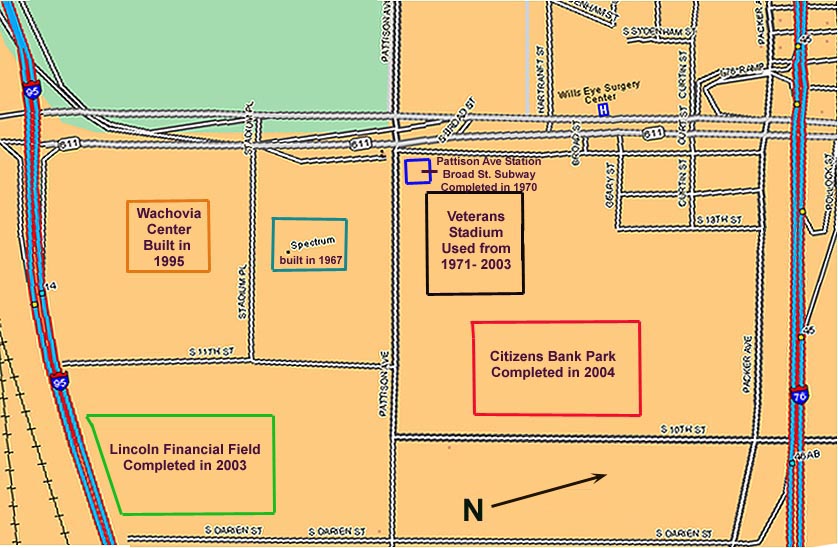
This paper was originally written, back in May, 2000 for the
Urban Political Geography course I took at Ohio State University,
taught by Prof. Kevin Cox.
I found this paper in
January, 2003 and got around to placing it on roadfan.com on April
14, 2004.
Questions and comments about the subject matter here can be
directed to roadfan@copper.net
Return to the Philadelphia Virtural Roadtrip
or the Igglephans link page
